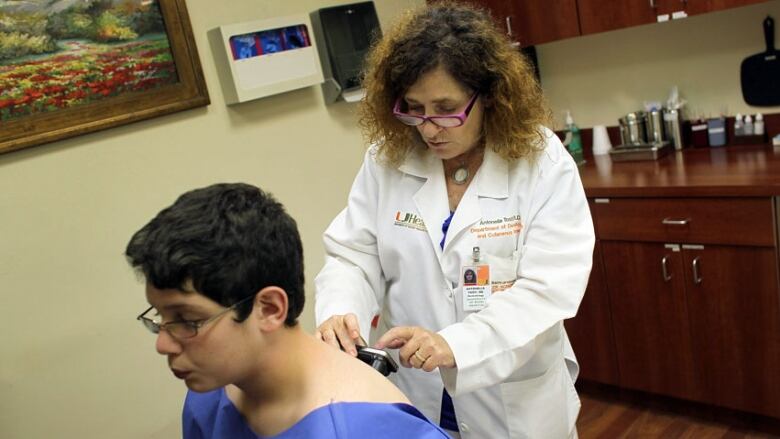New techniques help curb advanced melanoma
'Real progress' being made in dealing with deadliest form of skin cancer

Melanoma, a preventable skin cancer, is one of the most deadly forms of the disease if it is not found early.
But doctors say there are now new treatment options for some advanced forms of the malignancy.
Dr. DavidHogg is a medical oncologist at Princess Margaret Cancer Centre in Toronto. Hes been treating advanced melanoma patients for 15 years.
"We've gone from an absolutely dismal situation a decade ago to a situation where we're now starting to see real progress,"Hoggsaid.
Skin cancer, though, is still the most common cancer, with an estimated 6,500 new cases of malignant melanoma expected to be diagnosed this year, the Canadian Cancer Society notes.
For the society, prevention is the main focus, given that ultraviolet or UV radiation causes about 90 per cent of melanoma cases. People can be overexposed to UV from the sun and indoor tanning beds.
Limiting time outside when the sun is at its peakand wearing sunscreen are simple protections.
- Vanity, sunscreen fatigue behind the rise in skin cancer
- Cancer outcomes better for married, partnered patients
In fact, the the Canadian Dermatology Association suggests encouraging children how to spot shade, such as from trees or buildings, and to teach them the rhyme: "When my shadow is long, I can go out and have fun. When my shadow is short, I stay out of the sun."
At the other end of the age spectrum, dermatologists encourage seniors to be aware that some medications can cause the skin to be more sensitive to the sun, and canlead to sunburn, blisters and rashes.
People of all ages are encouraged to cover up in the sun, wear shades and use ample sunscreen.
Its also important to check your skin regularly for changes. The Melanoma Network of Canada describes the ABCDE signs to look for and when to head to a doctor:
- Asymmetry the shape of one half of a mole on the skin doesnt match the other, so if you imagine folding it in half, the two sides dont line up.
- Border edges are normally smooth oval or circles. Moles to be concerned about have irregular borders that are notched or blur into the surrounding skin with a ragged, notched or uneven edge.
- Colour instead of a uniform brown, black or tan, a mix of brown, salmon colour, white and black is something to be concerned about.
- Diameter watch for a mole over 6 mm or inch in diameter or changes in size.
- Evolution changes in size, shape, colour, surface or appearance are especially important to watch. Also check for new growths.
If melanoma is found and treated early, such as with surgery, doctors say chances of survival are excellent.
Brakes on cancer
In cases of advanced (stage four) melanoma, where the cancer has spread into the bloodstreamor lymphatic system, Dr.Hogg says there are now two major thrusts in terms of treatment:
- Using targeted agents, which utilizethe same mutations that drive and protect the growth of cancer cells, to fight it.
- Immunotherapy getting the immune system to target melanoma.
The biggest group of targeted agents approved in Canada and the U.S. are called kinase inhibitors and focus on the BRAF gene found in about 40 to 50 per cent of melanoma tumours.
The drugs are capsules given by mouth, the tumours respond quickly with mostly manageable side-effects.
To explain immunotherapy, Hogg uses the analogy of getting a car to move:
1) Turn iton, or in this case, get the immune system to recognize melanoma as foreign.
2) Hit the accelerator. The immune systems equivalent is a "costimulatory signal" that tells immune cells to become active and attack.
3) Use the brakes. The immune system has elements that shut it down once an infection clears.
"The problem with the brakes in cancer is that cancer doesn't disappear," Hogg said. Thats why the newer methods of immunotherapy all involve trying to hide one or more of the so-called brakes.

But no treatment is perfect. Targeted agents are powerful tools but they often stop working, and they only work for melanomas that bear a particular mutation.
And activating the immune system can increase the risk of severe diarrhea due to inflammation of the bowel if not managed properly.
Hogg said the findings that are starting to spill over into lung cancer, kidney cancer and gynecological cancers. We're the poster child for oncology now."
With files from CBC's Amina Zafar












_(720p).jpg)


 OFFICIAL HD MUSIC VIDEO.jpg)
.jpg)



























































































